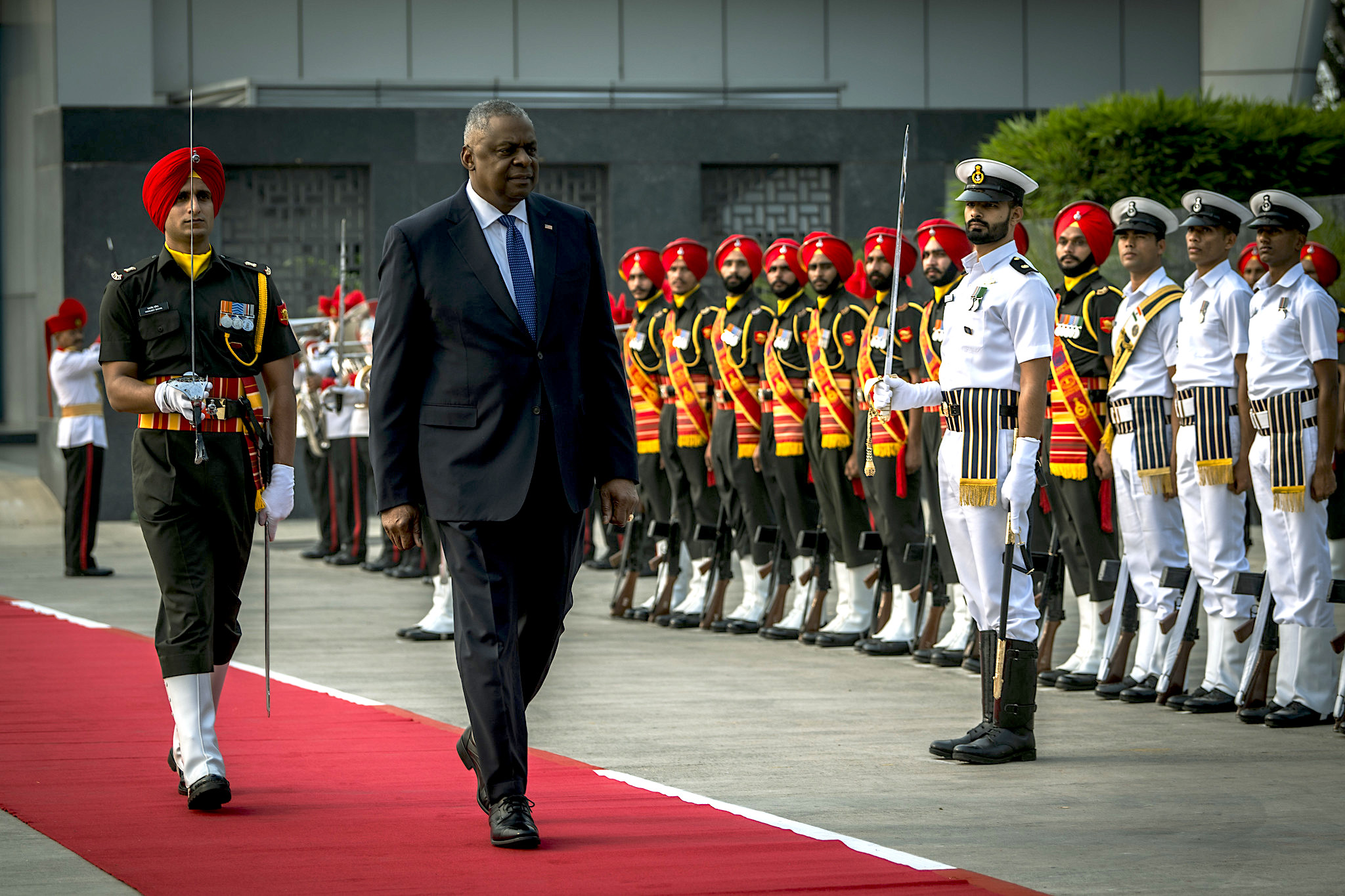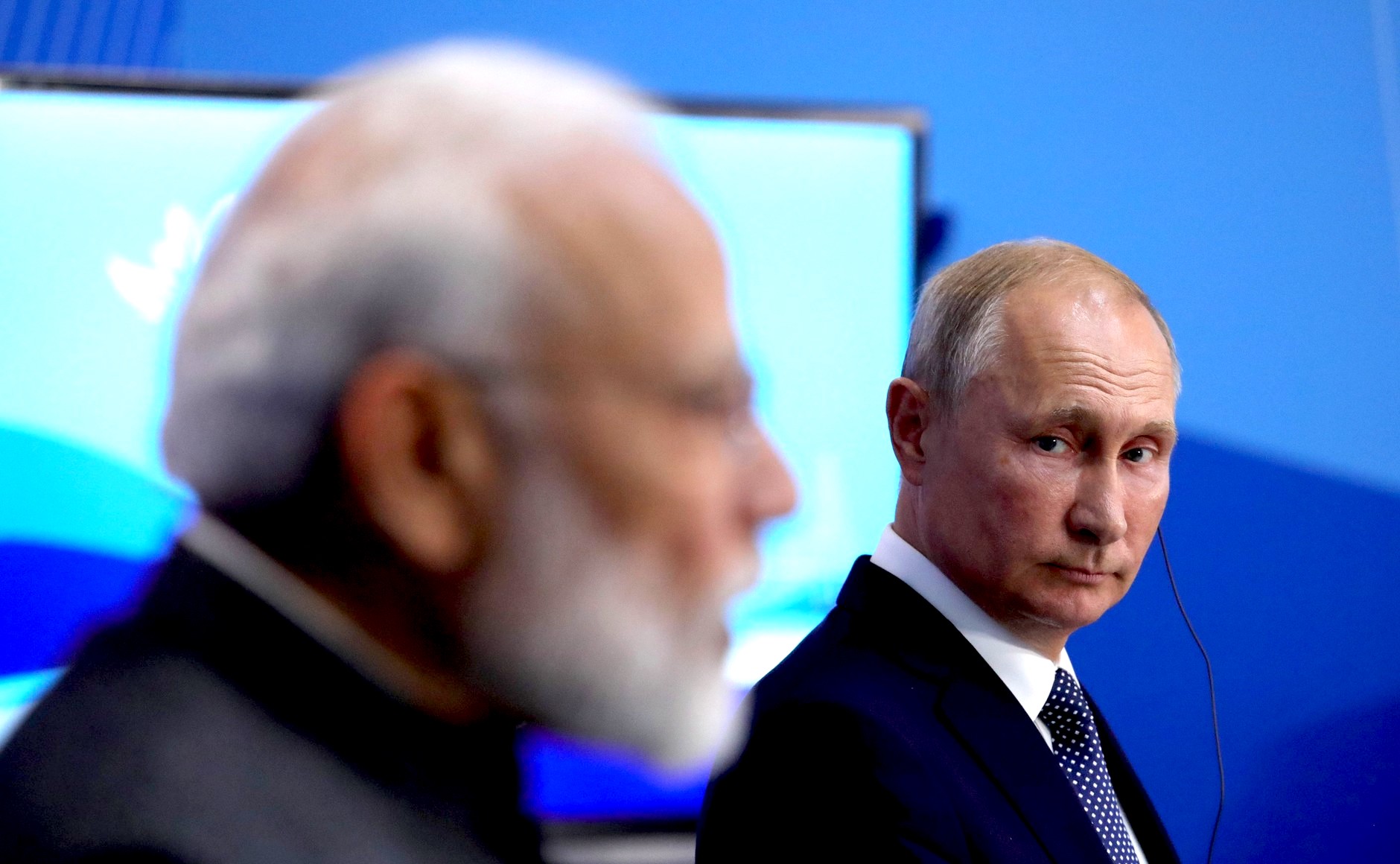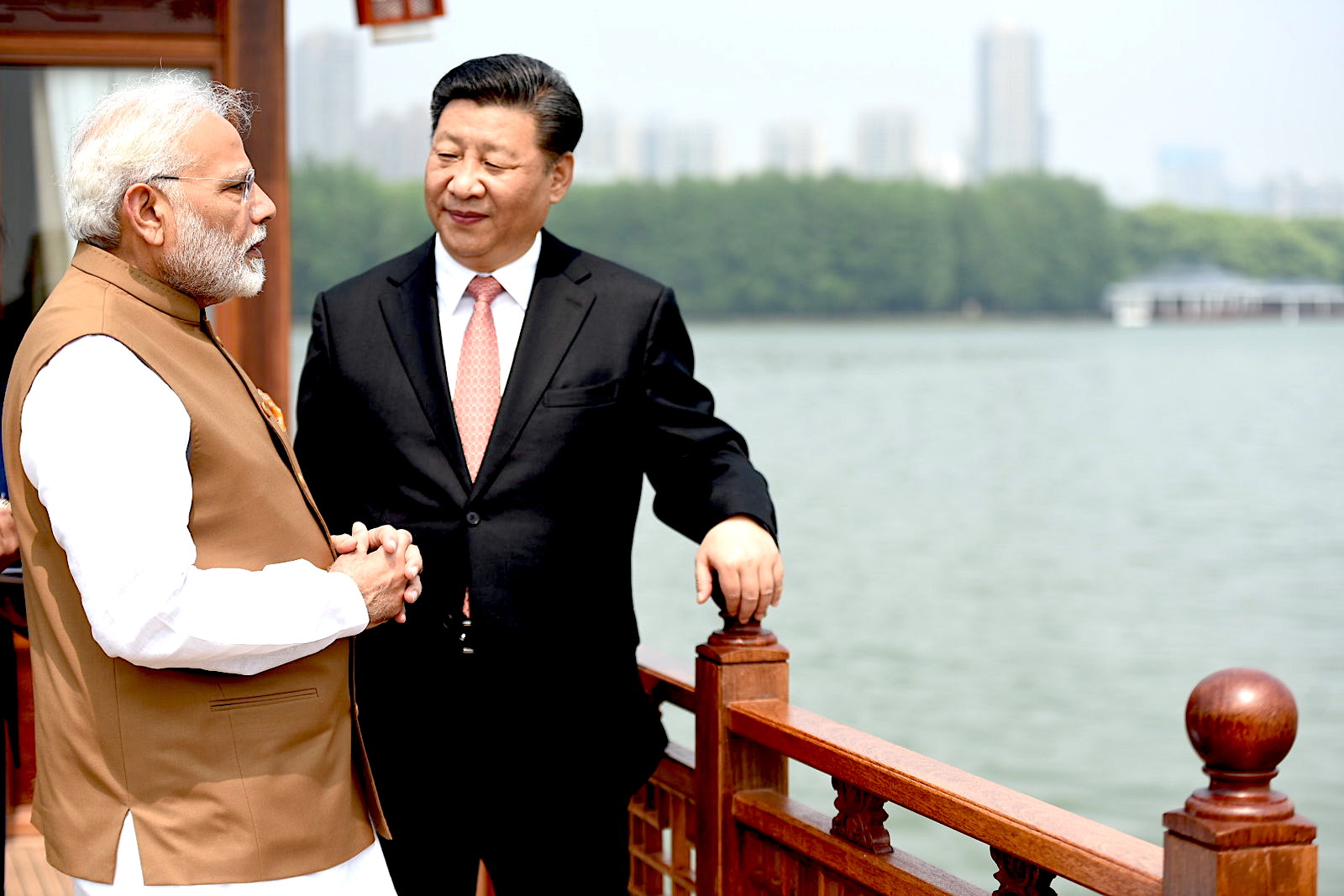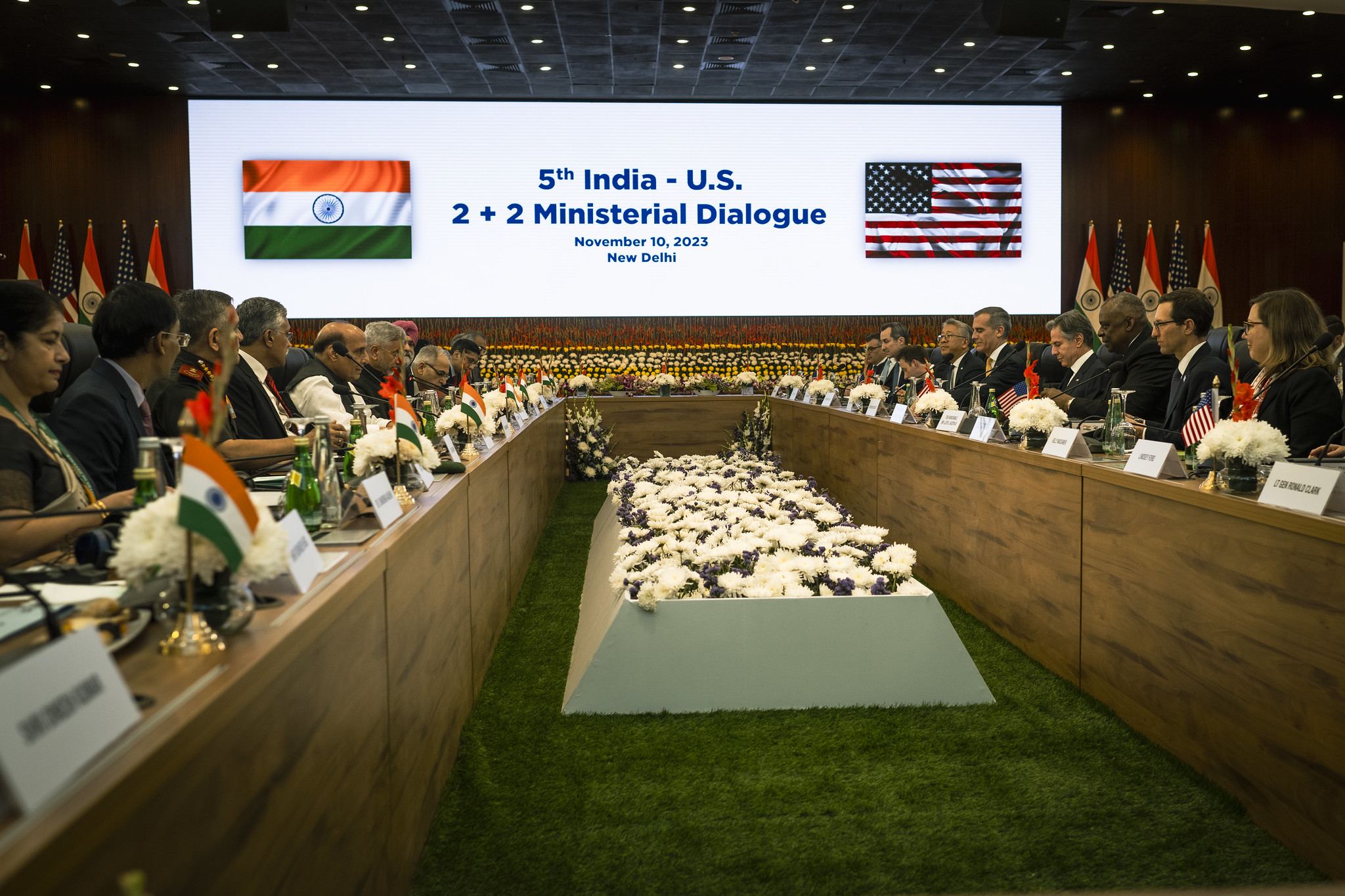After the meeting of U.S. and Indian foreign and defence ministers, M.K. Bhadrakumar says Delhi is shedding its strategic ambivalence and joining Washington‘s adversarial stance on China.

U.S. Secretary of Defense Lloyd Austin on the red carpet in New Delhi on Nov. 9. (DoD, Chad J. McNeeley)
By M.K. Bhadrakumar
Indian Punchline
 If the United States is a declining power and China’s rise inevitable in the Indo-Pacific; if Russia regards itself as a global power and is determined to bury the U.S.-dominated rules-based order; if the defeat of the U.S. and NATO in the Ukraine war has become a fait accompli; if Canada was encouraged by the U.S. to fret and fume over alleged Indian involvement in the killing of the Canadian Sikh separatist leader Hardeep Singh Nijjar on Canadian soil; if Israel’s bloodbath in Gaza is actually genocide — well, India’s policymakers haven’t heard any of this.
If the United States is a declining power and China’s rise inevitable in the Indo-Pacific; if Russia regards itself as a global power and is determined to bury the U.S.-dominated rules-based order; if the defeat of the U.S. and NATO in the Ukraine war has become a fait accompli; if Canada was encouraged by the U.S. to fret and fume over alleged Indian involvement in the killing of the Canadian Sikh separatist leader Hardeep Singh Nijjar on Canadian soil; if Israel’s bloodbath in Gaza is actually genocide — well, India’s policymakers haven’t heard any of this.
That is the message from the U.S.-Indian 2+2 foreign and defence ministers meeting in New Delhi on Nov. 10.
The big picture is that after audaciously claiming the mantle of leadership of the Global South as recently as in September, in a span of over two months, India is gliding over to the American camp as the U.S.’ indispensable ally, even aspiring to be a “global defence hub” with Pentagon’s help.
The following were some of the takeaways at the 2+2 meeting:
- Sharing technology relating to “maritime challenges, including in the undersea domain”;
- co-development and co-production of ground mobility systems;
- India to undertake U.S. aircraft maintenance and mid-voyage repair of U.S. naval vessels;
- U.S. investment in India’s maintenance, repair, and overhaul of U.S. aircraft and unmanned aerial vehicles;
- finalisation of a Security of Supply Arrangement, which will deepen the integration of defence industrial ecosystems and strengthening of supply chain resilience;
- creation of new liaison positions between the two armed forces further to India’s full membership of the multinational Combined Maritime Forces, headquartered in Bahrain;
- Maximisation of the scope of the Logistics and Exchange Memorandum Agreement, and identify steps to enhance the reach of the U.S. naval vessels to Indian bases.
No doubt, the above is only the tip of the iceberg, while this extraordinary transition in Indian policies will largely remain behind closed-doors. The U.S. seems supremely confident that India is ready to enter into an exclusive alliance, something that New Delhi never sought with any big power. What is the offer that the Biden administration has made to India that the latter cannot refuse?
No Sign of Partisan Concern
Clearly, such a massive shift in India’s military policies needs to be correlated with the fundamental postulates of foreign policy. That said, curiously, call it “bipartisan consensus” or whatever, India’s main opposition party apparently couldn’t care less about the shift. This is not surprising. The shift is actually about a nascent India-U.S. alliance to counter China — and that is a policy front where it is difficult to choose between Tweedledum and Tweedledee.
To be sure, both Russia and China understand that Indian foreign policy is transitioning. But they pretend not to notice and would hope it is an aberration. At any rate, neither Russia nor China can stop India in its tracks. Their capacity to leverage Indian policies has dramatically shrunk — Moscow’s in particular — in the contemporary security environment.

Indian Prime Minister Narendra Modi and Russian President Vladimir Putin in a press conference in Russia in 2019. (Kremlin, Wikimedia Commons, CC BY 4.0)
The heart of the matter is that India is not ecstatic about the growing multipolarity in the world order. India is a beneficiary of the “rules-based order” and feels far more comfortable with a bipolar world order where multipolarity, if at all, remains a fringe phenomenon while the U.S.’ pre-eminence will continue to prevail for decades to come.
Such a paradigm is perceived as advantageous for India to navigate its pathway toward checking China’s hegemonic instincts while also optimally developing its own comprehensive national power. It is an ambitious agenda which is risky too, as policies change in Washington as presidents come and go and American interests get redefined and priorities change.
Animus Against China

Modi and Chinese President Xi Jinping in Wuhan, China. 2018. (MEAphotogallery, Flickr, CC BY-NC-ND 2.0)
Today, however, the Indian willingness to align with the U.S. is more evident than ever before. The animus against China’s rise was palpable at the 2+2 meeting. India has cast away any residual pretensions and is shifting toward an openly adversarial relationship with China. The QUAD has become an important locomotive. To be sure, a Chinese response can be expected — when or in what form, time will tell.
This is only possible because Delhi feels reasonably assured that Washington’s Indo-Pacific focus remains intact under the Biden administration despite growing engagement with China seen in the summit meeting between Chinese President Xi Jinping and Biden in San Francisco with both sides hoping to make the Sino-American relationship more predictable.
Focus on Afghanistan, Ukraine & Gaza

U.S. Defense Secretary Lloyd Austin and Secretary of State Antony Blinken meeting with their Indian counterparts, Defense Minster Rajnath Singh and Minister of External Affairs Dr. S. Jaishankar, at the 2+2 ministerial meeting in New Delhi on Nov. 10. (DoD, Chad J. McNeeley)
The three regional issues that figured prominently at the 2+2 were Afghanistan, Ukraine and the Palestine-Israel conflict. The joint statement devoted a separate paragraph with the sub-title Afghanistan, which implicitly accused the Taliban rulers of not adhering to their “commitment to prevent any group or individual from using the territory of Afghanistan to threaten the security of any country.”
The joint statement went on to pointedly recall UNSC Resolution 2593 (2021), which specifically “demands that Afghan territory not be used to threaten or attack any country or to shelter or train terrorists, or to plan or finance terrorist attacks.”
Delhi is making a radical departure from its attempts to constructively engage with the Taliban rulers. One reason could be intelligence inputs to the effect that Afghanistan is once again becoming a revolving door for international terrorist groups.
A second possibility could be that the U.S. and India share a sense of exasperation over the Taliban’s growing proximity with China and the spectre of Afghanistan turning into a hub of the Belt and Road Initiative. Beijing’s plan to build a road connecting Afghanistan via the Wakhan Corridor is a geo-strategic game changer. Anything that relates to the security of Xinjiang is of incessant interest to Delhi.
[Related: Why the New Silk Roads are ‘Threat’ to US Bloc]
The 2+2 joint statement signals a renewed U.S.-Indian convergence on Afghanistan. How far this would translate as proactive moves is a moot point. Notably, the U.S. and its allies are also exploiting Russia’s preoccupations with the conflict in Ukraine to double down on their post-Cold War strategy to roll back Russian influence in Afghanistan. Moscow senses that it is losing ground in its backyard.
When it comes to Ukraine and the Palestine-Israel conflict, what emerges is that the U.S. and Indian sides have succeeded in harmonising their respective positions on these crucial regional conflicts.
Delhi is shedding its strategic ambivalence and moving towards the U.S. position. This comes out in the strokes in the joint statement by what it says and what it doesn’t. Thus, on Ukraine, Russia’s attritional war has “consequences predominantly affecting the global South.” This apart, Moscow can learn to live with the 2+2 formulation on the Ukraine war.
As regards the West Asian situation, the joint statement voices vehement support for Israel’s fight against “terrorism.” But here, again, India refuses to call out Hamas. Nor is India endorsing Israel’s war on Hamas, leave alone pre-judge its chances of success. Most important, the joint statement omits any reference to Israel’s “right to self-defence,” a mantra constantly on Biden’s lips.
[Related: Craig Murray: The Right of Self-Defense]
India cannot possibly call the Gaza war an act of “self defence” when Israel has unleashed such a brutal military operation against hapless civilians and razed Gaza City to the ground — reminiscent of the joint British-American aerial bombing attack on the city of Dresden, the capital of Saxony, during World War II, which killed over 25,000 German people.
M.K. Bhadrakumar is a former diplomat. He was India’s ambassador to Uzbekistan and Turkey. Views are personal.
This article originally appeared on Indian Punchline.
The views expressed are solely those of the author and may or may not reflect those of Consortium News.

How foolish. If you lie down with the United Snakes of America it will surely bite you. And its bite is fatal.
I believe India under Modi is squandering a wonderful opportunity for a role in leading the world into multipolarity. As usual, the Indians have so much potential that they consistently waste in trying to keep the old order of things despite always mouthing innovation and progress. How can you progress while refusing to accept change? Their starry eyed enamour with the West is causing them to be irrational.
Modi is a cancer on his own people. He’s now switching to the U.S. side against China. Oh my, and how much more money will go to Modi rather than to Americans who need help? But then, Modi is an awful man and not kind to its many citizens. In cleaning up the showy parts of the nation, I read that Modi just razed housing of many kinds, because what was there was so poorly made that it should not exist. NO hope for the poor of India, it appears. I wonder how much money Modi got from America?
The west will do to India what they did in Ukraine sow resentment towards their neighbour China and in 10 years time they will fule the fire of war then make promises to fight the war to the last Indian. Just like Ukraine, don’t abandon your neutrality Indra. The US military industrial state will make billions of dollars at the expense of Indian and Chinese blood.
On purely economic interests, India’s largest source of imports is in China, and the largest export market is in USA. Thus is a double vulnerability, but her size gives considerable strength too. India also has some delusion of grandeur that every potential government has to give a lip service. This explains the lofty interests in “the situation in Xinjiang and Afghanistan”.
On the exports to USA, India is potentially vulnerable to American sanctions involving products produced with components from Russia and China. As these American policies are hopelessly political (undermining putative benefits to American industry), humoring USA on military cooperation is a cheap way of avoiding them (because of Pakistan, this cooperation will not go too far, IMHO) Perhaps even Russian diamonds will be transmuted into Namibian or whatever.
My bigger worry is about anti-Muslim aspects of Hindutwa. At least in foreign policy, Modi “triangulates” too, domestically, it looks rather ugly. Again, India has deep dependency on Gulf remittances, while Modi does not care about non-alignment tradition originating from Indian Congress Party, he is keen on business interests.
Piotr, excellent points. Modi is quite like Erdogan in several respects–chiefly, that he loves to cozy up to multiple players to get the most he can from a situation. The USA in its usual hypocrisy derides Hindu nationalism though it MSM mouthpieces, seen as growing in its extreme under Modi, while making any deal to ensure they remain in Modi’s good graces.
You are certainly correct that the USA export market is too big a herd of elephants in the room to think much will change quickly. But then the USA is good at shooting itself in the foot with their sanction wars, and perhaps they will do some foolish thing to provoke India at some point leading them to decide they need to get super-serious about their BRICS+ membership. Only time will tell. I’m just sick and tired of every US deal being yet another military “support” agreement. Such wasted money on weapons to destroy what should be cherished.
I wonder if this isn’t more about fear of China than anything else. India’s huge neighbour is taking all the oxygen, and would seem to be overshadowing India’s aspirations for greatness.
Does Modi think he is using the US for his advantage, or is the US using India for its’? I think the latter is certainly true, and that India may soon come to regret its shift.
Modi is hitching his wagon to the wrong horse. Thinking the US empire will continue to be the dominant force in global politics for decades more is doomed to fail. Such is the fate of nations ruled by megalomaniacs.
“The heart of the matter is that India is not ecstatic about the growing multipolarity in the world order. India is a beneficiary of the “rules-based order” and feels far more comfortable with a bipolar world order where multipolarity, if at all, remains a fringe phenomenon while the U.S.’ pre-eminence will continue to prevail for decades to come.”
While reading that it occurred to me that this attitude is quite in keeping with the Hindu embrace of caste. As is heard is diverse settings these days – “There is an order in things…” to justify any old ancient regime, even the withering American century. Just a thought which popped up; the author’s other points of geopolitics are surely more in play.